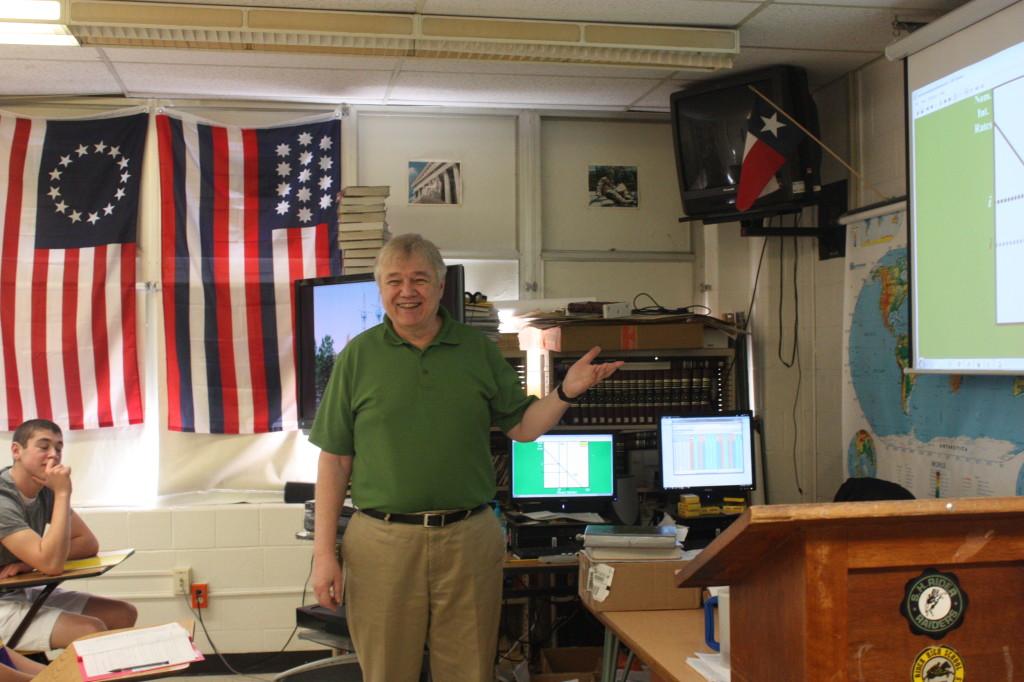40 Years and Counting
Social Studies teacher’s career started in 1974
Standing at the front of the classroom another class listens in as history teacher Joe Pearson lectures.It is the 40th year for these lessons. Lessons that range from the class topic to life after high school to the infamous “Pearson Puns”.Things have changed since Pearson first stepped foot in the classroom in 1974.
“To some degree [students] families are less stable today,” Pearson said. “[There’s an] increase in the number of children being raised by
grandparents.”
That change, one Pearson no longer finds surprising, is something he says wasn’t very common at all back when he first started teaching.The classroom itself has changed also. Pearson said when he first started teaching there were more boys in AP classes but now there are more girls.
It’s complicated to know the exact reason why, he admits, but he believes that it has a lot to do with girls being given more status through academic ability, while guys get more status through athletic ability.
“Girls who are good students get more respect than guys who are good students,” Pearson said.
Another factor may be that women were once withheld from the same rights as men, so now being equals, women embrace the opportunities that have been presented.
“In our culture, we have begun to emphasize the importance of giving young women the opportunity to fully use their abilities and that has made a very positive impact in the number of girls in the AP classes,” Pearson said.
On top of that, classes are more diverse now. Usually when diversity is talked about, it’s referred to by race and gender, but it also refers to “social and economic diversity,” Pearson said.
He teaches students who have been raised in a variety of different backgrounds, which he thinks does more to add perspective and greater talent to the classroom.
He said just because an individual was less fortunate in their upbringing, doesn’t mean they’re any less capable in accomplishing their goals.
“Poor kids are not stupid kids,” Pearson said. “Poor kids are smart kids, and the way to stop being poor is to get a good education and use that to get where you want to go.”
Pearson has confidence in the abilities of students who push hard to succeed in life and always will.
Teaching has changed significantly. When he first started teaching there were six classes a day. Now there are eight. That change has led to an increase in stress for teachers and students.
“Teachers are more worn out,” Pearson said. “ And students have a tendency of cutting and pasting from the Internet.”
The Internet has changed more than research methods for students. “Students are less aware of the world around them,” Pearson said. It’s become rare for him to find a student who reads the paper.
“Students really don’t follow the news very closely at all,” Pearson said. “It’s really kind of scary.”
However, students do stay connected.
“The degree to which students are immersed in technology, particularly social media,” Pearson said. Pearson worries that in today’s society the number of teenagers killed texting while driving has out done the number of teens killed drinking while driving.
He also worries about how communication has changed because of technology.
“There is part of us that needs face-to-face communication,” Pearson said.
Pearson said the lack of this communication has changed the culture.
“Teenage culture has become very harsh. People tend to be more nasty when they don’t see each other.” It’s not all bad, though. Pearson sees a lot more awareness of money with today’s teenager, in large part because of the numbers working.
“Students are having to earn part of it, and that gives them more responsibility when they start spending money,” Pearson said. “More students are having to pay at least something for what they get. It’s not all being handed to them.”
That awareness has led to a social awareness as well. Pearson said today’s students are more aware of social issues and poverty problems, which he finds as a positive aspect. He said students are taking more initiative now to care for the environment, which is vital to its survival. He said that same attention should go towards those who are in poverty as well though.
“Many AP students come from better off families, so to really understand what we live in, you need to have an appreciation and thankfulness for the blessings you’ve been given, because they didn’t come from you,” Pearson said.
He feels that being appreciative of this will help people to understand how great of a debt they owe, to do something for those who weren’t offered the same advantages they were.
“In other countries you have people that make our poor look wealthy,” Pearson said.
It is important for people to really embrace what has been provided for them and help others, because they never know when they’ll
be in a rough spot.
“Not having gratitude for the advantages you’ve been given is really damaging to people,” Pearson said. “It makes you arrogant.”
Gratitude and awareness led to Pearson’s teaching career, and while he does worry about the pressure new teachers are under, in the end Pearson said he wouldn’t change a thing about his life in the classroom. He had an amazing English teacher when he was in high school, and that made him realize the responsibility he had to give back in the educational field.
“Being able to make a difference is the thing he enjoys most about teaching.” Pearson said.
He loves learning and admires watching the students develop and be able to achieve what they want to in life. And although there are sometimes bumps along the road, “teaching becomes less difficult when you get grey hair,” Pearson said.

